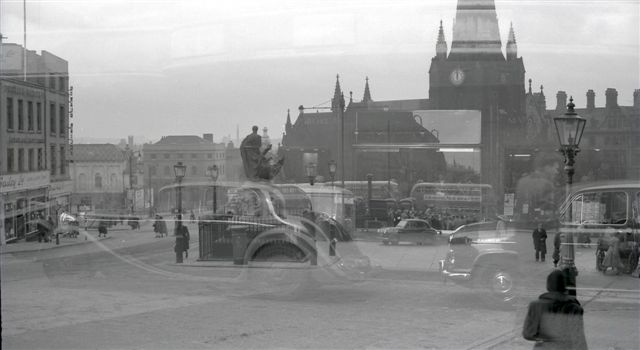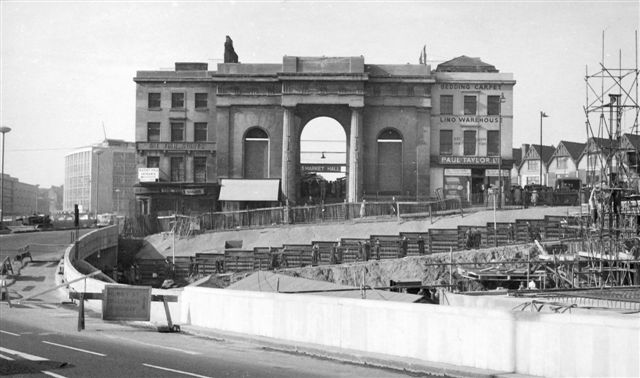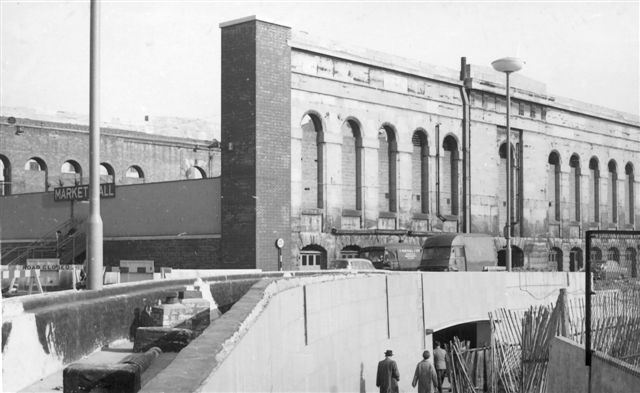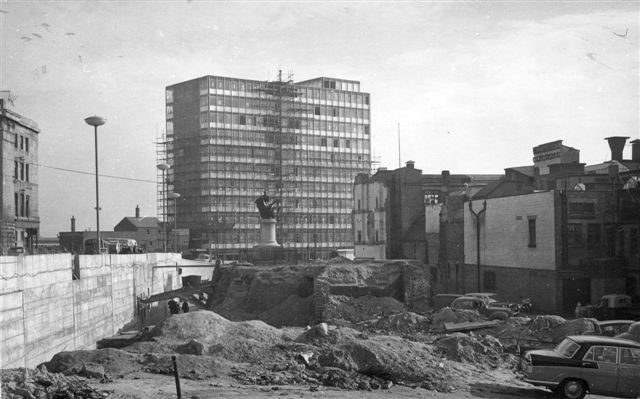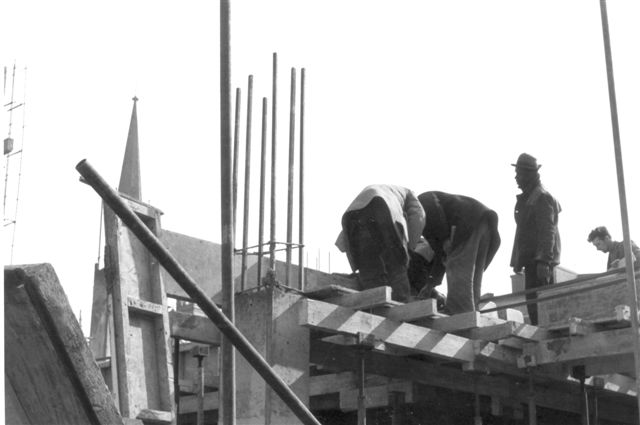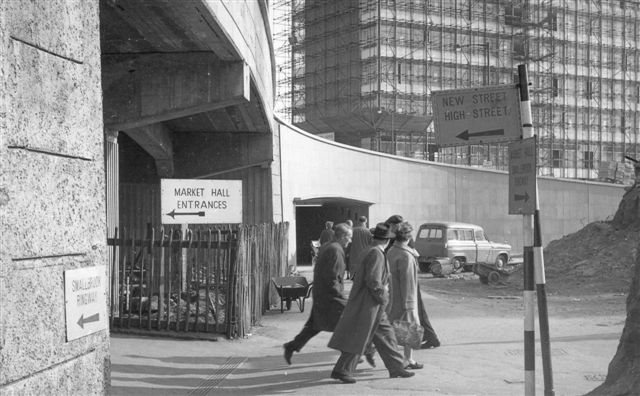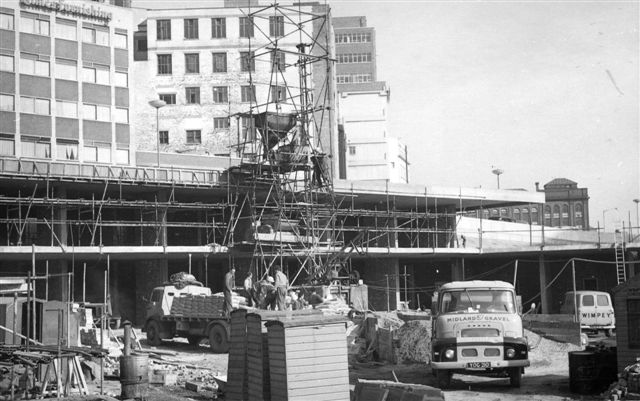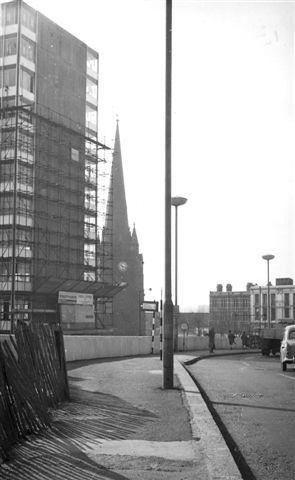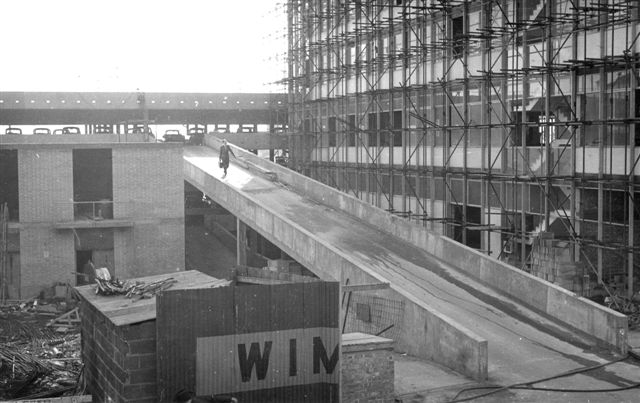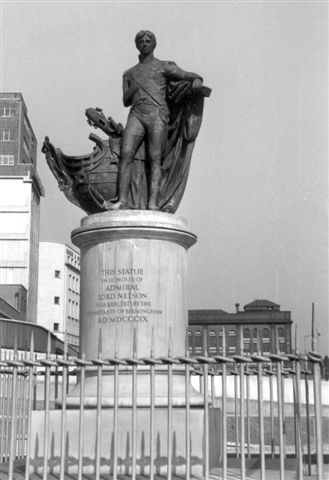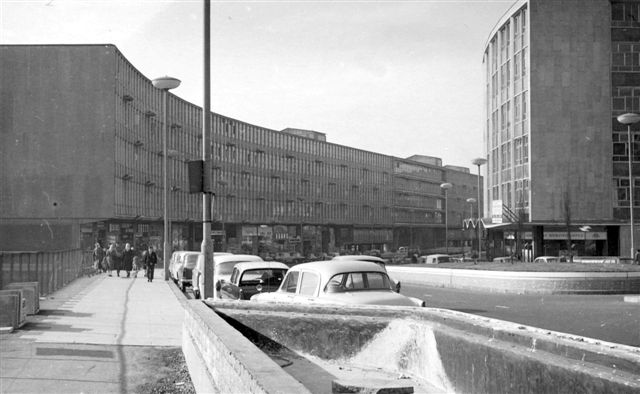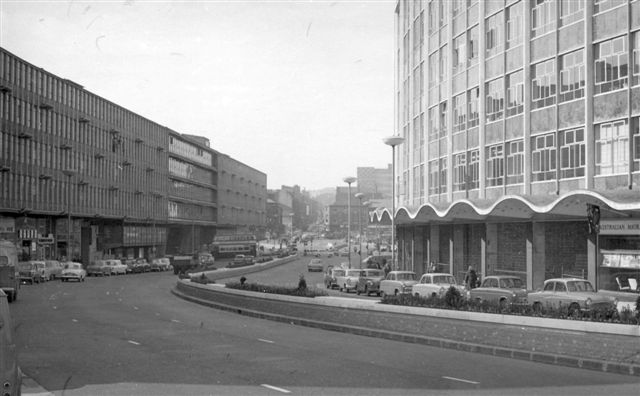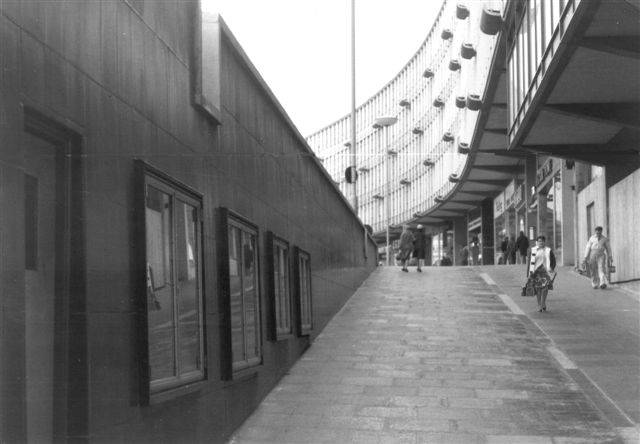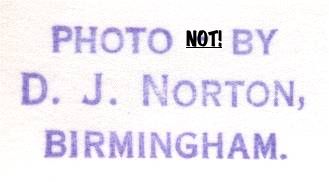
Bull Ring and Inner Ring Road by Leonard Stace
After Bill Stace saw the
first
page of his father's photographs and began to realise their
importance, he supplied me with some additional ones. While not
capturing the charm of the old city, they were just as important as
they showed Birmingham undergoing vast changes. Most of the
pictures below show the construction of the new Bull Ring outdoor
market in the early 1960's while the remainder illustrate parts of the
Inner Ring Road.
It is perhaps hard to believe that the parts of the city being
constructed in many of these scenes would last for less than 40 years
before being swept away for the current Bullring shopping centre.
It is easy to forget how bad it had become in such a short period and I
highly recommend that you visit
this
website
to remind you! I would like to thank the webmaster of Howlers for
allowing the use of two of their photo's to help explain the locations
of Leonard's shots.
If you have any old Birmingham photographs you would like to see
displayed on this website, please get in touch via the 'Contact' link
on the
Homepage.
Bull Ring (double exposure)
|
|
|
You could easily get upset that
this classic view of the Bull Ring looking towards St. Martin's had
been the victim of a double exposure. However, looking upon
things in a more positive way it's easy to appreciate that we have two
pictures for the price of one!
The view of the Bull Ring shows it as it was before any work started so
it must have been taken before 1958. The second picture seems to
me to have been taken through the window of a bus. Two cars are
parked at the side of the road. To the left is an older style
vehicle with some very fancy, metal trim. To the right is a more
'modern' car and a chap stands in the street chatting to the
passenger. Above this scene there appears to be a canopy with a
curving front featuring projecting rectangles, something that should
easily identify the location to anyone who can remember such a
structure in the city. Where St. Martin's stands is what I
believe to be the reflection of the window on the other side of the
bus. Looking through this, we effectively have a third view of
the city! Through this window I can just about make out some
people stood by the road and some rather odd curved projections that,
again, might help identify the location of the double exposure.
Graham studied the picture and comments above and came up with this
theory:-
"Your Bull Ring 'double exposure' is, I think, a photo taken a few
yards before the Bull Ring. The photographer is
on a bus going down New Street, and has photographed the Odeon Cinema,
which is the facade you can see (the
cars are a 1946 Jaguar and a 1955 Morris Oxford parked outside) then
immediately taken the Bull Ring, leading
to the double exposure."
|
Market Hall
|
|
|
I suspect that these two
splendid photo's of the old Market Hall were taken in early 1961.
The St. Martin's Circus Queensway section of the Inner Ring Road was
actually constructed around the market hall and the building survived
until November of 1961 when it demolished and replaced by Manzoni
Gardens. What a sad end to such a magnificent building.
According to the British
History website, it had been constucted between 1828 and 1835 and
although it lost its roof to a fire due World War 2, it continued to
function thereafter.
I find the lower shot particularly interesting. At the bottom, a
subway can be seen. I believe that this subway lead from Manzoni
Gardens to the low level pathway that ran from Smallbrook Queensway to
the open market. Opposite the subway was an entrance to the Bull
Ring shopping centre and I seem to recall there being a pet shop nearby
when I visited in the 1980's - I can still remember the smell!
Robert recalls that it was called 'Pims (or Pimms?) Pets', later
renamed 'Animal Magic'.
|
Looking Towards Bull Ring
|
|
|
I think this picture was taken
from the same position as the one above but Leonard had turned around
45 degrees to the right. In front of us is the site of the fish
market that stood on the corner of Bell Street and Spiceal
Street. To the left is the old Market Hall and the shops adjacent
to the Woolworths
store are to the right.
This made me feel quite sad when I first saw it what with Nelson stood
alone as the city was being reconstructed around his ears. I then
realised that he did not appear to be in the correct spot, closer to
the Market Hall. I guessed that he was moved once to make way
for the ring road and outdoor market and then moved again when his new
spot was ready and Mark, of the Nelson Society, provided
this information:-
"You asked whether the statue moved twice during the Ring Road/Bull
Ring development and the answer is most definitely YES. The first move,
as you suggest, was just a few yards sideways, roughly to the corner of
Bell Street, where it is shown in this picture. I have pictures which
show the scaffolding around it on 11th September 1959 (in the original
location), then pictures of it sitting in the Public Works depot on
21st October and finally an announcement in the Evening Despatch of
28th October that it was in it's new location "in the shadow of the
Market Hall." No official unveiling took place as far as I can make out.
I don't yet have all the precise dates of the second move, except to
say that it was unveiled on the Bull Ring 'balcony' on 17th
November 1961 - by Alderman Eric Mole."
|
Near the Bull Ring
|
|
|
Here's a scene that would be
have been familiar to Birmingham residents as the new Bull Ring took
shape - steel reinforced concrete buildings being erected. Note
the spire of St. Martin's church to the upper left of the picture.
|
Bull Ring Near Woolworths
|
|
|
This view was taken from where
the pathway from Smallbrook Ringway met the outdoor market. To
the upper left is the Inner Ring Road held high by the concrete columns
and, at the time the picture was taken, the old Market Hall was
accessible from the ramp that led towards High Street. To the
right of the photographer was the site that the new Woolworths store
would be built on.
Here
is a picture was taken from outside of Woolworths in the late 1990's
looking towards where Leonard took his shot (he would have been on the
far left). Compare the concrete
columns supporting the road with those seen above.
|
Bull Ring Near Ramp
|
|
|
This was where the outdoor
market was surrounded by roads on three sides! Out of shot to the
left was where the ramp provided access to the markets. The shop
units in the middle would later contain a chippy that was very popular
and I recall sitting by the statue of Nelson, surrounded by pigeons
many times in my youth... Nelson would later be sited on the far
right of the above shot, as shown below.
Here
is a picture taken from the ramp showing this area as it was in the
late 1990's - note the shop units to the left.
|
Bull Ring
from Moor Street Ringway
|
|
|
This picture was taken from Moor
Street Ringway looking towards the Bull Ring. On the left is a
new office block that features in many of the pictures on this page
thus providing a good point of reference. To the left of the lamp
post is the tower and spire of St. Martin's church and on the far right
the old Woolworths store can be seen.
|
Concrete Ramp Off Moor Street Ringway
|
|
|
Here, Leonard has walked forward
a few paces from the position of the shot directly above and has peered
over the concrete fence. The ramp to the car park is indicative
of the modern and functional style being inflicted throughout the city
centre.
|
Nelson
Statue in New Bull Ring Site
|
|
|
With progress on the new Bull
Ring markets being made, it was now possible to move Nelson to his new
home feet away from the busy Inner Ring Road. The plinth tells us
that the statue was originally erected in 1809. It managed to
stay in the same place for over 150 years but would be in its new home
for less than 40… Nelson is now a prominent
feature in the new Bullring. I wonder how long he will be
left in peace for this time!?
|
Smallbrook Ringway
|
|
|
This section of the Inner Ring
Road at Smallbrook Ringway was the showpiece for the project and was
completed first. The upper two pictures show Norfolk House to the
right and the Ringway Centre to the left. The latter building was
designed by James A. Roberts who would later go on to provide
Birmingham with its most iconic building - the Rotunda.
The lower shot is from close to Hurst Street looking back towards the
Bull Ring. Today, the road no longer occupies the high ground as
it did it was constructed; instead, cars and people all operate at the
same (low) level and the once familiar underpass lined with shops has
long gone.
The observant will note that I refer to Smallbrook Ringway here but to
Smallbrook Queensway elsewhere on the site. Well, there is an
interesting story there! When the original parts of the ring road
were constructed, they were named Ringway (note Moor Street Ringway above). When the
Queen came to Birmingham in April 1971 to open the Queensway tunnel,
she inadvertently referred to the whole Inner Ring Road as the
Queensway thus all the roads had to be renamed!
It you do have interest in the 1960's architecture that was introduced
to Birmingham then I recommend you have a read of 'Signalling
the Sixties' (1.3Mb PDF) produced by the council's planning
department.
|

|

|



